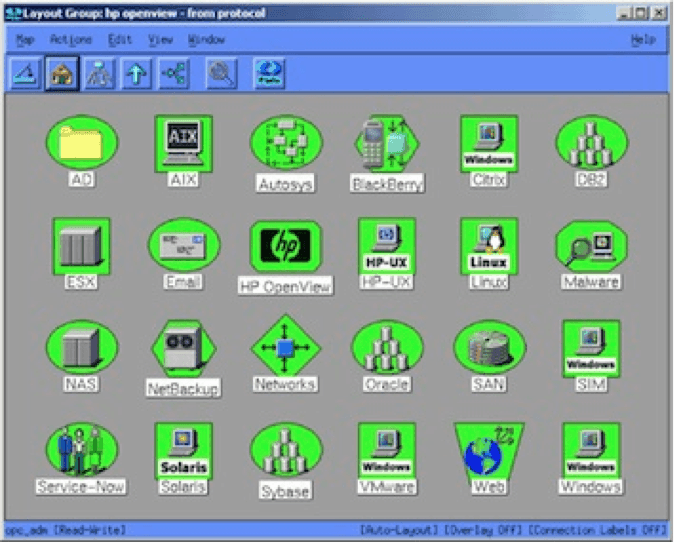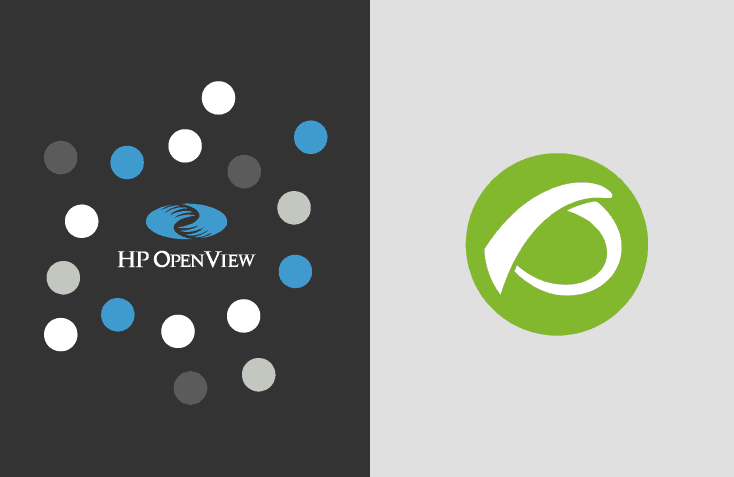HP OpenView is a very extensive suite of software products (more than 50 core products) that attempts to cover most IT department management issues.
Openview is not a software, but a huge suite of different tools aimed at managing system performance and availability.
The source of these tools is very diverse, resulting from acquisitions of different products over the last 30 years.
HP Open View and its 80’s aesthetic
The design of the OpenView/OM interface has an aesthetic typical from the 80s, which suggests that it was created with the Unix philosophy of the time. Anyone who has seen an X-based management interface knows what we’re talking about:

Network Node Manager (NNM) was the first product of the suite, released in the mid-1980s; soon after they sold the auto-discovery algorithm to IBM’s competitors: Tivoli.
HP Operations Center came to NNM in the late 1980s as an “add-on” to provide monitoring and management over servers and applications, and added the ability to access systems through RPC, rather than just through SNMP.
In 1995, Operations Center and NNM were integrated due to the popularity of the Operation Center. The first version that integrated them was ITO v3.x, the first version and the basis of what would end up being known as “OpenView” years later. Today there are more than 50 products under the “OpenView” umbrella.
Over time, OpenView has been acquiring different companies that it has integrated into its suite, and in 2007 HP “renamed” the OpenView suite under the name of HP Operations Manager.
HP Open View Competitors
Traditionally, OpenView has been compared to Patrol, Tivoli or Spectrum, products that come to mind when thinking of tools of similar size; but sometimes we can find smaller alternatives that can give better solutions at a much more affordable price, in addition to being much more agile for the implementation and adaptation to a constantly changing environment.
So far we have made some comparisons of different monitoring applications, but this time the technical comparison would be extremely complex, so we preferred to just compare, at the architectural level, the equivalences and similarities.

Alternative to HP Open View: Pandora FMS
A single software tool and a single license against the puzzle made up by different pieces with different licenses.
In a simplified way, and always in the monitoring domain, you may say that, to carry out the same actions that Pandora FMS brings together in a single tool, OpenView/Operations Manager needs the following components (individually licensed):
• HP OpenView Network Node Manager (OV NNM) – Network monitoring.
• HP Operations Manager (OM) – System and application monitoring using agents.
• HP OpenView Performance Agent (OVPA) – Agent
• HP OpenView Performance Insight (OVPI) – Agent
• HP OpenView Performance Manager (OVPM) – Agent
• HP OpenView Reporter (OVR) – WEB reporting system.
• HP OpenView GlancePlus – Diagnostic and data collection tool in the face of issues.
• HP Software Business Availability Center (BAC) – Made up by thirteen different products, including transactional business monitoring, user experience monitoring and others.
• HP Software SiteScope (SiS) – Agentless application performance monitoring.
• HP Service Information Portal (SIP) – An end-user tool that provides WEB views of data generated by OpenView. It allows to customize views for each user (client), so that they can be assembled from data from different HP applications: OVO, OVSN, NNM, OVIS, OVPM, OVPI, Reporter.
• HP OpenView Internet Services (OVIS) – It provides a simple interface for Internet-related services. It has a WEB dashboard for operators.
Each technology (SPI) we want to integrate with the HP suite needs to be purchased separately, with its own license and integration: Oracle, Sybase, DB2, SQL, AD, Exchange, Citrix, VMware, WebSphere, PeopleSoft, WebLogic, etc.
In contrast, in Pandora FMS this is done with plugins that are included in the Enterprise license.
The OpenView suite has elements that cover more aspects that Pandora FMS does not cover:
– Automation and orchestration (Data Center Automation).
– Storage management
– Configuration management
– Universal CMDB
– Service Desk
– Transaction analyzer
These latter features exceed the scope of monitoring and encompass infrastructure management and administration, where HP software is predominant; Pandora FMS remains exclusively in the scope of monitoring. We are talking about a suite that consists of hundreds of different by-products under the umbrella of “HP Operations Manager” (formerly OpenView).
The size and complexity of the HP suite is beyond question. This makes it very complex to implement and extremely costly. For a complex environment where NNM, OM, OVPA, OVPI, OVR, BAC, SIP, OVIS, SiteScope must be employed, it is necessary for them to integrate with each other. This involves many hours of consulting, and represents a challenge for the team in charge of managing that infrastructure.
Lower cost, same features and better scaling. Enough to try Pandora FMS?
With Pandora FMS you may achieve the same results as with HP, but with a very small fraction, not only in license costs, but more importantly, in complexity.
Pandora FMS is a monitoring product designed in 2005 and constantly evolving to the present day.
It was born when the Internet and Linux had already become popular, as well as other essential concepts today such as virtualization or heterogeneous and decentralized environments, which today represent the day-to-day of large environments. This makes it much more agile and better integrated than the HP suite.
Pandora FMS has success stories where it has replaced HP in large environments, and this is due to a very simple premise: same feature, lower cost, less complexity.
Many of them using the Open Source version.
You want to use it?
Pandora FMS’s editorial team is made up of a group of writers and IT professionals with one thing in common: their passion for computer system monitoring. Pandora FMS’s editorial team is made up of a group of writers and IT professionals with one thing in common: their passion for computer system monitoring.


















